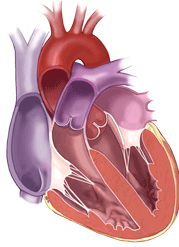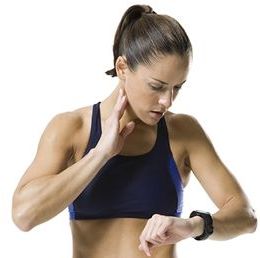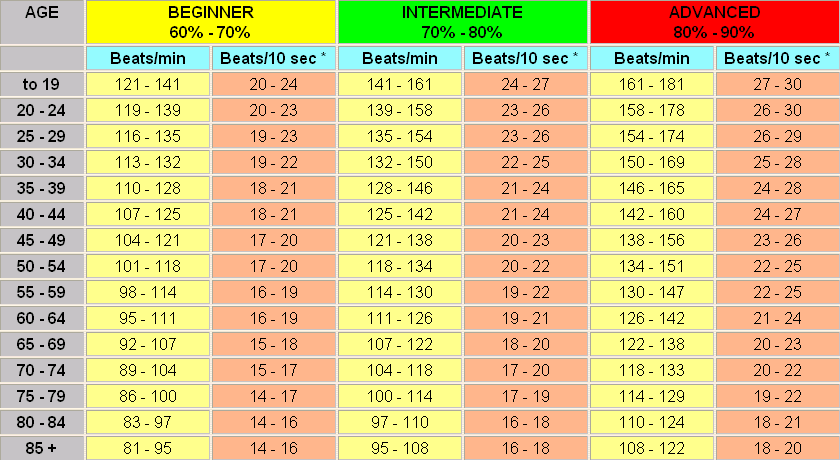Knowing how to measure your heart rate or pulse, can help you to learn about your own degree of fitness and can help to detect potential medical problems:
- Your Heart Rate
- Your Pulse
- Normal Heart Rate
- Reducing Your Heart Rate
- Target Heart Rate
- Recovery Heart Rate
- Your Heart Rate and Exercise
- Calculate Your Target Heart Rate
Your heart rate is the number of times your heart beats per minute. You can measure your heart rate by feeling your pulse – the rhythmic expansion and contraction (or throbbing) of an artery as blood is forced through it by the regular contractions of the heart. It is a measure of how hard your heart is working.
Your pulse can be felt at the wrist, neck, groin or top of the foot – areas where the artery is close to the skin. Most commonly, people measure their pulse in their wrist. This is called the radial pulse.
Taking your pulse is easy. It requires no special equipment, however, a watch with a second hand or digital second counter is very helpful.
- Turn the palm side of your hand facing up.
- Place your index and middle fingers of your opposite hand on your wrist, approximately 1 inch below the base of your hand.
- Press your fingers down in the grove between your middle tendons and your outside bone. You should feel a throbbing – your pulse.
- Count the number of beats for 10 seconds, then multiply this number by 6. This will give you your heat rate for a minute.
Example:
If you count 12 beats in the span of 10 seconds, multiply 12 X 6 = 72.
This means your Heart Rate or pulse, is 72 (or 72 beats per minute).
Another popular way to measure pulse rate is by measuring it at the neck (carotid pulse). This is especially convenient during exercise. The formula is the same as above, however, when taking the pulse at the neck, place your fingertips gently on one side of your neck, below your jawbone and halfway between your main neck muscles and windpipe:
Taking your pulse upon rising in the morning, or after sitting without activity for about 10 minutes, is know as your Resting Heart Rate.
Your Normal Heart Rate anywhere in the range of 60 – 100 is considered in the normal range. Your Heart Rate will fluctuate a lot depending on such factors as your activity level and stress level. If however, your pulse is consistently above 90, you should consult with your physician. This condition is called tachycardia (increased heart rate).
Many athletes have pulse rates in the 40 – 60 range, depending on how fit they are. In general, a lower pulse rate is good. Sometimes however, one’s heart rate can be too low. This is known as bradycardia and can be dangerous, especially when blood pressure gets too low as well. Symptoms include weakness, loss of energy and fainting. If this situation applies, medical attention should be sought immediately.
If the pattern of beats or throbs you count is irregular (i. e. a beat is missed) take your pulse for a full minute. If you experience irregularities in your pulse on a consistent basis, you should consult with your personal physician.
Many factors influence heart rate. These include emotions, temperatures, your position or posture (sitting, standing, laying down), and your body size (if you are overweight for your size, your heart will have to work harder to supply energy to your body).
A decrease in resting heart rate is one of the benefits of increased fitness due to exercise. Before starting into any exercise regimen, however, be sure to consult with your personal physician.
Your heart is a muscle and will respond just like any skeletal muscle in that it will become stronger through conditioning. If your heart muscles are stronger, then your heart rate will decrease. In other words, your heart will be putting out less effort to pump the same amount of blood.
When undertaking an exercise program it is important to have a goal and a target range that you are trying to accomplish in each workout. To be of benefit, you want the workout to be neither too hard nor too easy. There is a simple formula to predict your maximum heart rate:
Take 220 and subtract your age.
This will give you a predicted maximum heart rate.
For example, if you are 42 years old, subtract 42 from 220 (220 – 42 = 178). This means that your maximum physiological limit as to how fast your heart should beat is 178 beats per minute.
Most exercise programs suggest that when someone is just getting started that their heart rate during exercise should not exceed 60 – 70% of their maximum heart rate. Therefore, given the example above, 60% of 178 = 107 beats per minute. As you progress in your exercise, the percentage of your maximum heart rate to be set as a goal can be gradually increased.Calculating a target heart rate zone is often desirable. To do so:
- Start with your maximum heart rate as shown above.
- Multiply your maximum heart rate by 0.8 to determine the upper limit of your target heart rate zone (divide this product by 6 to get the rate for a ten-second count).
- Multiply your maximum heart rate by 0.6 to determine the lower limit of your target heart rate zone (divide this product by 6 to get the rate for a ten-second count).
Example:
For a person 42 years old:
220 – 42 = 178 Maximum Heart Rate
178 X 0.8 = 142 Upper Limit of Target Heart Zone (142/6 = 24,10 sec. count)
178 X 0.6 = 107 Lower Limit of Target Heart Zone (107/6 = 18, 10 sec. count)
Note: Your maximum heart rate is the most your heart should reach after a strenuous workout.
Your Heart Rate should be measured during warm-up, halfway into your workout, at the end of your workout and at the end of your cool-down period. If during exercise you exceed your upper limit, decrease the intensity of your workout. Conversely, at the end of your workout if your heart rate is much lower than your target, you need to work harder next time.
One way to determine if you are reaping the benefits from exercise is to calculate your Recovery Heart Rate, a measure of how quickly you return to your resting heart rate after a workout. To calculate your recovery heart rate:
- Take your pulse ten seconds immediately after you have finished exercising. Write down the number.
- One minute later, take your pulse again and write it down.
- Subtract the number for the second pulse check from the number for the first pulse check. This number is your Recovery Heart Rate. The greater the number, the better shape you are in!
Exercise Programs and your Heart Rate
Exercise programs help to increase the strength of the heart. Declines will be seen in resting heart rate, and hopefully, blood pressure, and stress levels as well. Overall body changes will also be experienced including weight loss and increase of lean body mass.
Remember, however, that it is important to check with your doctor and seek out a qualified exercise physiologist before your get started. An exercise stress test may be advised to help ensure the training parameters that are best for you.
Calculate Your Target Heart Rate
Calculate Your Target Heart Rate
Calculate your target heart rate, given as a range to use for aerobic exercise. Click the button below and answer two questions: your heart rate and your age.That’s all!





Comments 3
Pingback: Bradycardia in children | Cardiac Health
My pulse rate is between 43 to 50. I do my walk (not slow but moderate fast walking)in the morning for 50 minutes at a strech and 15 minutes free hand exercise. At the time of walking no breathing problem. I do it Monday to saturday every week,
Please advice whether my heart rate is a concern. recently done an ECG and it’s report says Synus bradicardia. My age is 56 years.
Regards
My pulse is 52 beat per minute. Is it number? I am a male of 44 years.